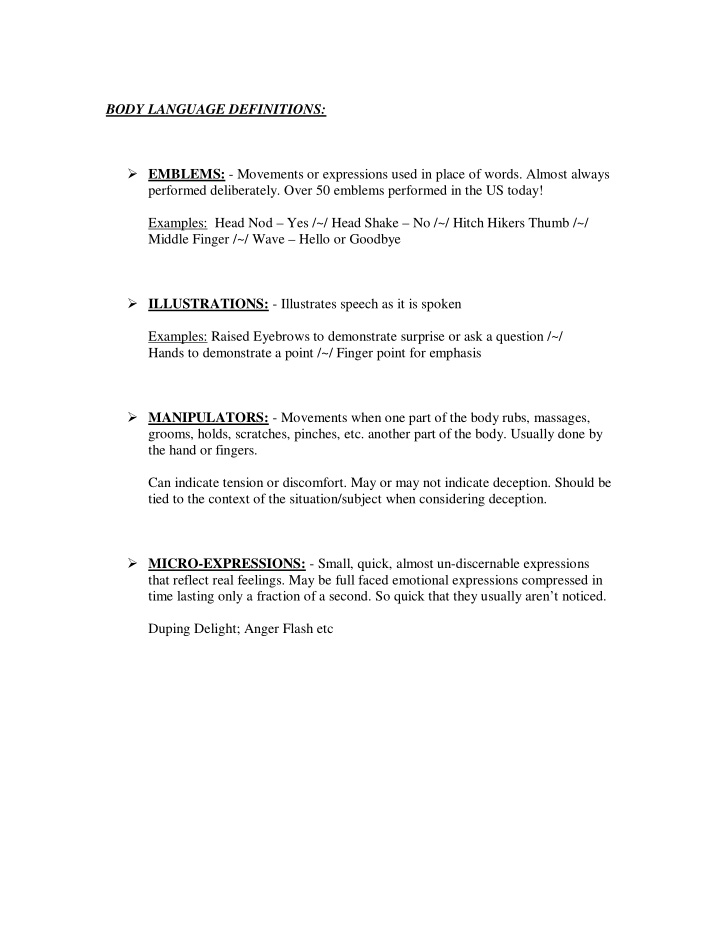



BODY LANGUAGE DEFINITIONS: EMBLEMS: - Movements or expressions used in place of words. Almost always performed deliberately. Over 50 emblems performed in the US today! Examples: Head Nod – Yes /~/ Head Shake – No /~/ Hitch Hikers Thumb /~/ Middle Finger /~/ Wave – Hello or Goodbye ILLUSTRATIONS: - Illustrates speech as it is spoken Examples: Raised Eyebrows to demonstrate surprise or ask a question /~/ Hands to demonstrate a point /~/ Finger point for emphasis MANIPULATORS: - Movements when one part of the body rubs, massages, grooms, holds, scratches, pinches, etc. another part of the body. Usually done by the hand or fingers. Can indicate tension or discomfort. May or may not indicate deception. Should be tied to the context of the situation/subject when considering deception. MICRO-EXPRESSIONS: - Small, quick, almost un-discernable expressions that reflect real feelings. May be full faced emotional expressions compressed in time lasting only a fraction of a second. So quick that they usually aren’t noticed. Duping Delight; Anger Flash etc
BODY LANGUAGE FACTS: 7% OF THE INFORMATION WE RECEIVE IS FROM WHAT PEOPLE ACTUALLY SAY. UP TO 38% OF INFORMATION IS FROM TONE, INFLECTION & THE SPEED OF THEIR VOICE. A STAGGERING 55% OR MORE OF THE INFORMATION IS FROM OTHER PEOPLE’S BODY LANGUAGE!
INTERVIEW PREPARATION: KNOW AND SET CLEAR & REALISTIC OBJECTIVES. HAVE A TYPE OF ROAD MAP OF HOW TO REACH YOUR GOALS. SET WHAT YOU WANT / EXPECT INTERVIEWEES TO PROVIDE. SET THE INTERVIEW ROOM UP; PREPARE A THOROUGH LIST OF QUESTIONS. HAVE SPECIFIC / CRITICAL QUESTIONS LISTED. INSURE COMPLETE CONTROL OF THE ROOM / AREA. REVIEW ALL FILES / INFORMATION YOU HAVE AVAILABLE. CONSIDER USING RUSES AS PART OF YOUR INTERVIEW PLAN. PLAN HOW MAKE THE INTERVIEWEE COMFORTABLE. PLAN TO TAKE THE TIME TO ESTABLISH RAPPORT. START WITH SOFT BALL QUESTIONS. ESTABLISH RECIPROCITY. UNDERSTAND AND USE RECIPROCITY. PLAN TO USE RELECTION QUESTIONS; “WHAT WOULD YOU DO OVER” LET NO QUESTIONS GO W/O COMPLETE ANSWERS. INSIST ON COMPLETE ANSWERS! TRY TO MAKE PART OF THE INTERVIEW A CONVERSATION. ASK ABOUT FEELINGS. PLAN HOW TO REPEAT KEY QUESTIONS IN DIFFERENT WAYS. DON’T FEEL UNCOMFORTABLE ASKING TOUGH QUESTIONS. VAN RITCH – THEPREFERREDEDGE@GMAIL.COM
LET THE INTERVIEWEE KNOW THE PURPOSE OF THE INTERVIEW. RECORD & SUMMERIZE YOUR OBSERVATIONS OF THE INTERVIEWEE. USE TECHNOLOGY; !!! TEST YOUR EQUIPMENT !!! HAVE BACK UPS! SUBTLY MIRROW BOSY LANGUAGE – PRACTICE DOING THIS! USE BOTH OPEN & CLOSED QUESTIONS. ASK ABOUT THINGS YOU ALREADY KNOW THE ANSWER TO. USE SILENCE AS PART OF YOUR QUESTIONING TECHNIQUES. SHARE A STORY TO MAKE A POINT OR ASK A QUESTION. CONSIDER USING SOME ELICITATION TECHNIQUES. ALWAYS FOLLOW UP ON LESS THAN COMPLETE ANSWERS! VAN RITCH – THEPREFERREDEDGE@GMAIL.COM OFFICE 941-531-4006 CELL 941-705-2968
POOR LISTENERS GOOD LISTENERS Aren’t really interested in the information Look for interesting parts Pre-judge what the speaker will say Keep an open mind Day dream Stay tuned in Listen half heartedly Listen completely Stand or sit far away Are close to convey interest Forget most of the conversation Get & report key information Let themselves get bored Stay interested Only hear some information Receive verbal & non-verbal ===================================================================== FALSE ASSUMPTIONS ABOUT LISTENING It’s easy Good listening equates to good hearing As we gain more experience our ability to listen improves The ability to read & the ability to listen are related It is the speakers responsibility to get the point across =========================================================== The average US worker spends time in the following manner: WRITING = 14% READING = 17% SPEAKING = 16% LISTENING = 53% VAN RITCH – THEPREFERREDEDGE@GMAIL.COM - 941-531-4006
WHY DO SOME PEOPLE LI LIKE TO TALK? They’re just naturally Social. They’re friendly! Like to teach and help others. Prove they are in the know. Want to be seen as important. Like to have the last say. Want to add to what others say. To feel like they belong. Like to get attention. Feels as though it gives them control. Van R Ritch h - TheP ePref efer erred edEdge@ e@Gmail.com Offi ffice - 941-531-4006 Ce Cell-941-705-2968
Recommend
More recommend